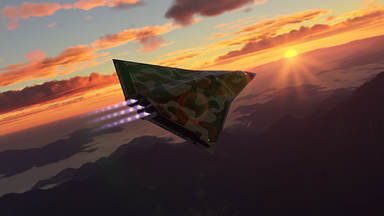

Chengdu J-36
Meet the Chengdu J-36, the PLAAF's newest fighter-bomber currently undergoing certification. The aircraft is stealthy and features a unique, unconventional three-engine design, a groundbreaking innovation that marks a new era in modern combat doctrine. This aircraft is agile, fast, and versatile! Developed by Marine RM, the J-36 features an integrated cockpit for its two-person crew, complete with a HUD, navigation systems, AP, radio, and interactive aircraft function management. The model was developed with 4k PBR textures for the best possible simulation quality. Enjoy!







When you start on the runway, your aircraft will be ready for flight. If you're starting cold and dry, consider pressing the STARTER button on the panel in front of you. Wait 1 minute for the engine to fully ignite and monitor the EICAS (first screen on the left panel) as the engine RPM and temperature increase to the ideal level. In the meantime, you can experiment with the Chocks or GPU display. When taking off, consider briefly using the afterburner, as there will be ample power available due to the three engines in the fuselage.
Using the Autopilot is simple, but requires prior guidance: you must click on the desired function before starting digitation to click enter. Use the ENT buttons to confirm what you've entered or the CLR button to clear and enter again. It is always necessary to click on the desired function before entering. Consider always starting to configure your AP by maintaining altitude, so first press the ALT button and then enter the desired value, and press ENT if the final value has less than 4 digits. Above 5 digits, the value is automatically applied by the AP. Next, set your desired speed or HDG, or even GPS navigation mode. If you want to remove speed control, click the A/T button in the upper right corner of the screen. Consider using the VS+ and VS- buttons to interact with climb mode.
IMPORTANT: Avoid using Mach control during climbs to avoid constant acceleration and deceleration; During the climb phase, if you want to use A/T, use the normal SPEED control, in knots, and after stabilizing your altitude, change to Mach if you wish.
The radio screen works similarly: click on the frequency type you want to change (COMM 1 or XPNDR) and enter the desired frequency, pressing ENT when finished, or CLR to clear your entry.
The new flight model implemented in update 1.2 provides that above 300 knots, the speedbrake will automatically engage if the thrust lever is at zero, to facilitate speed reduction at critical moments. The speedbrake will also automatically engage during landing if the parking brake is activated upon touching down. It is still possible to manually engage it at any stage of flight, but under any of the above conditions, its engagement and retraction will be automatic.
Your MDF panel displays local time, landing gear status, navigation light status, and flap status. When landing, note that your landing speed may be low, less than 140 knots, due to the shape of the aircraft. There are filters and digital controls to make the flight more stable during this phase, but some caution and skill are recommended for a safe landing.
Quick View 5 in the cockpit is a fixed camera on the outside of the aircraft with a HUD, for tactical flight similar to aerial combat games.

EICAS DISPLAY
AP VISUALIZER
AP CONTEXT MENU
STARTER
HSI
AIRCRAFT STATS
FAQ
There were several reports from users of unusual situations, but with a similar report: it was impossible to control the boat / the boat stalls in a certain direction - this is not a problem linked to the Add-On itself, but a missing setting in the game standard for more experienced simulations. Piloting assistants disable some features that break the mobility of boats in the water and cause situations where users cannot navigate - and unfortunately they end up, without knowing the reason, blaming the Add-On for this. These images show a recommended configuration for navigating with a keyboard, joystick or other external control hardware, bearing in mind that some of these hardware (especially those with a landing gear lever) may present unusual or unexpected situations due to the nature of the hardware - already that it was designed for runways and airplanes. Any questions, unusual or unexpected situations you face, please contact me via email for assistance.



